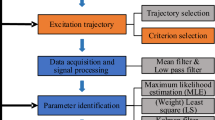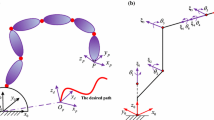Abstract
Dynamics-based methods have wide applications in the control of elastic joint robots. These methods require accurate robot dynamic parameters and hysteresis models of elastic elements for the controller designs. Existing independent identification procedures for the dynamic parameters and hysteresis models are challenging to efficiently implement without specific calibration equipment. In this paper, an iterative identification method that unifies the dynamic parameter identification and hysteresis model identification based on an energy identification model is proposed. This method can be conveniently implemented through simple trajectory tracking experiments. The energy identification model includes the elastic potential energy caused by the elastic elements with hysteresis. Any derivative of velocity can be avoided in this form. A two-step iterative strategy is proposed, including the initialization and main steps. The initialization step is implemented to obtain the a priori knowledge of the dynamic parameters as the initial values for iteration. The main step aims to identify the hysteresis model and dynamic parameters iteratively. Experiments on a two-degrees-of-freedom elastic joint robot verify the effectiveness of the proposed method.









Similar content being viewed by others
Availability of data and material
All related data is available in the manuscript. However, the data will be made available upon request.
References
Zhang, T., Xia, J.: Interconnection and damping assignment passivity-based impedance control of a compliant assistive robot for physical human-robot interactions. IEEE Robot. Auto. Lett. 4(2), 538–545 (2019). https://doi.org/10.1109/lra.2019.2891434
Yu, H., Huang, S., Chen, G., Pan, Y., Guo, Z.: Human-robot interaction control of rehabilitation robots with series elastic actuators. IEEE Trans. Rob. 31(5), 1089–1100 (2015). https://doi.org/10.1109/TRO.2015.2457314
Pratt, G.A., Williamson, M.M.: Series elastic actuators. In: Proceedings 1995 IEEE/RSJ International Conference on Intelligent Robots and Systems Human Robot Interaction and Cooperative Robots1995, vol. 1, pp. 399–406
Li, Y., Tong, S., Li, T.: Fuzzy adaptive dynamic surface control for a single-link flexible-joint robot. Nonlinear Dyn. 70(3), 2035–2048 (2012). https://doi.org/10.1007/s11071-012-0596-7
Wang, H., Zhang, Y., Zhao, Z., Tang, X., Yang, J., Chen, I.M.: Finite-time disturbance observer-based trajectory tracking control for flexible-joint robots. Nonlinear Dyn. 106(1), 459–471 (2021). https://doi.org/10.1007/s11071-021-06868-4
Albu-Schäffer, A., Ott, C., Hirzinger, G.: A unified passivity-based control framework for position, torque and impedance control of flexible joint robots. Int. J. Robot. Res. 26(1), 23–39 (2016). https://doi.org/10.1177/0278364907073776
Albu-Schaffer, A., Hirzinger, G.: State feedback controller for flexible joint robots: a globally stable approach implemented on DLR's light-weight robots. In: Proceedings 2000 IEEE/RSJ International Conference on Intelligent Robots and Systems (IROS 2000) (Cat No00CH37113)2000, vol. 2, pp. 1087–1093
Keppler, M., Lakatos, D., Ott, C., Albu-Schäffer, A.: Elastic structure preserving (esp) control for compliantly actuated robots. IEEE Trans. Rob. 34(2), 317–335 (2018). https://doi.org/10.1109/TRO.2017.2776314
Marino, R., Nicosia, S.: Singular perturbation techniques in the adaptive control of elastic robots*. IFAC Proc. Vol. 18(16), 95–100 (1985). https://doi.org/10.1016/S1474-6670(17)59942-5
Giusti, A., Malzahn, J., Tsagarakis, N.G., Althoff, M.: On the combined inverse-dynamics/passivity-based control of elastic-joint robots. IEEE Trans. Rob. 34(6), 1461–1471 (2018). https://doi.org/10.1109/TRO.2018.2861917
De Luca, A., Siciliano, B., Zollo, L.: PD control with on-line gravity compensation for robots with elastic joints: theory and experiments. Automatica 41(10), 1809–1819 (2005). https://doi.org/10.1016/j.automatica.2005.05.009
Tomei, P.: A simple PD controller for robots with elastic joints. IEEE Trans. Autom. Control 36(10), 1208–1213 (1991). https://doi.org/10.1109/9.90238
Spyrakos-Papastavridis, E., Childs, P.R.N., Dai, J.S.: Passivity preservation for variable impedance control of compliant robots. IEEE/ASME Trans. Mechatron. 25(5), 2342–2353 (2020). https://doi.org/10.1109/TMECH.2019.2961478
Keppler, M., Raschel, C., Wandinger, D., Stemmer, A., Ott, C.: Robust stabilization of elastic joint robots by ESP and PID control: theory and experiments. IEEE Robot. Auto. Lett. 7(3), 8283–8290 (2022). https://doi.org/10.1109/LRA.2022.3187277
Moyr, J., x00F, Moreno J.X., Valenzuela, S.J.: Nonlinear PI"D"-type control of flexible joint robots by using motor position measurements is globally asymptotically stable. IEEE Trans. Auto. Control., pp. 1–8 (2022). https://doi.org/10.1109/TAC.2022.3194043.
Luca, A., Lucibello, P.: A general algorithm for dynamic feedback linearization of robots with elastic joints. In: Proceedings 1998 IEEE International Conference on Robotics and Automation (Cat No98CH36146)1998, vol. 1, pp. 504–510
Luca, A.D.: Feedforward/feedback laws for the control of flexible robots. Proceedings 2000 ICRA Millennium Conference In: IEEE International Conference on Robotics and Automation Symposia Proceedings (Cat No00CH37065), vol. 1, pp. 233–40 (2000)
Spyrakos-Papastavridis, E., Fu, Z., Dai, J.S.: Power-shaping model-based control with feedback deactivation for flexible-joint robot interaction. IEEE Robot. Auto. Lett. 7(2), 4566–4573 (2022). https://doi.org/10.1109/LRA.2022.3144781
Swevers, J., Verdonck, W., Schutter, J.D.: Dynamic model identification for industrial robots. IEEE Control Syst. Mag. 27(5), 58–71 (2007). https://doi.org/10.1109/MCS.2007.904659
Fu, Z., Pan, J., Papastavridis, E.S., Lin, Y.H., Zhou, X., Chen, X., et al.: A Lie theory based dynamic parameter identification methodology for serial manipulators. IEEE/ASME Trans. Mech., 1 (2020). https://doi.org/10.1109/TMECH.2020.3044758
Huang, S., Cheng, J., Zhang, J., Zhu, Z., Zhou, H., Li, F. et al.: Robust estimation for an extended dynamic parameter set of serial manipulators and unmodeled dynamics compensation. IEEE/ASME Trans. Mech, 1 (2021). https://doi.org/10.1109/TMECH.2021.3076519.
Jia, J., Zhang, M., Li, C., Gao, C., Zang, X., Zhao, J.: Improved dynamic parameter identification method relying on proprioception for manipulators. Nonlinear Dyn. 105(2), 1373–1388 (2021). https://doi.org/10.1007/s11071-021-06612-y
Wu, J., Wang, J., You, Z.: An overview of dynamic parameter identification of robots. Robot. Comput. Integrated Manuf. 26(5), 414–419 (2010). https://doi.org/10.1016/j.rcim.2010.03.013
Gautier, M.: Dynamic identification of robots with power model. In: Proceedings of International Conference on Robotics and Automation, vol. 3, pp. 1922–1927 (1997)
Gautier, M., Poignet, P.: Extended Kalman filtering and weighted least squares dynamic identification of robot. Control. Eng. Pract. 9(12), 1361–1372 (2001). https://doi.org/10.1016/S0967-0661(01)00105-8
Gu, Y., Wang, H., Cho, J.H., Lee, D.Y.: Identification of dynamic parameters of an industrial robot using a recursively-optimized trajectory. In: ICCAS 2010, pp. 1450–1455 (2010)
Presse, C., Gautier, M.: New criteria of exciting trajectories for robot identification. In: Proceedings IEEE International Conference on Robotics and Automation, vol. 3, p. 907–912 (1993)
Ayusawa, K., Rioux, A., Yoshida, E., Venture, G., Gautier, M.: Generating persistently exciting trajectory based on condition number optimization. In: 2017 IEEE International Conference on Robotics and Automation (ICRA). pp. 6518–6524 (2017)
Han, Y., Wu, J., Liu, C., Xiong, Z.: An iterative approach for accurate dynamic model identification of industrial robots. IEEE Trans. Rob. 36(5), 1577–1594 (2020). https://doi.org/10.1109/TRO.2020.2990368
Ni, H., Zhang, C., Hu, T., Wang, T., Chen, Q., Chen, C.: A dynamic parameter identification method of industrial robots considering joint elasticity. Int. J. Adv. Robot. Sys. 16(1) (2019). https://doi.org/10.1177/1729881418825217
Yin, W., Sun, L., Wang, M., Liu, J., Chen, X.: Design and parameters identification of flexible joint robot. In: 2017 IEEE International Conference on Mechatronics and Automation (ICMA), pp. 1297–1302 (2017)
Miranda-Colorado, R., Moreno-Valenzuela, J.: Experimental parameter identification of flexible joint robot manipulators. Robotica 36(3), 313–332 (2018). https://doi.org/10.1017/S0263574717000224
Petrea, R.A.B., Oboe, R.: A DOB-based Parameter Identification method for Series Elastic Actuators without Load-side Encoder.In: 2022 IEEE/ASME International Conference on Advanced Intelligent Mechatronics (AIM), pp. 1755–1762 (2022)
Jin, H., Liu, Z., Zhang, H., Liu, Y., Zhao, J.: A dynamic parameter identification method for flexible joints based on adaptive control. IEEE/ASME Trans. Mechatron. 23(6), 2896–2908 (2018). https://doi.org/10.1109/TMECH.2018.2873232
Ruderman, M., Iwasaki, M.: Sensorless Torsion control of elastic-joint robots with hysteresis and friction. IEEE Trans. Industr. Electron. 63(3), 1889–1899 (2016). https://doi.org/10.1109/TIE.2015.2453415
Taghirad, H.D., Be´langer, P.R.: Modeling and parameter identification of harmonic drive systems. J. Dyn. Syst. Measure. Control 120(4):439–444 (1998) . https://doi.org/10.1115/1.2801484
Ruderman, M., Bertram, T., Iwasaki, M.: Modeling, observation, and control of hysteresis torsion in elastic robot joints. Mechatronics 24(5), 407–415 (2014). https://doi.org/10.1016/j.mechatronics.2014.02.009
Ruderman, M., Hoffmann, F., Bertram, T.: Modeling and identification of elastic robot joints with hysteresis and backlash. IEEE Trans. Industr. Electron. 56(10), 3840–3847 (2009). https://doi.org/10.1109/TIE.2009.2015752
Sutor, A., Rupitsch, S.J., Bi, S., Lerch, R.: A modified Preisach hysteresis operator for the modeling of temperature dependent magnetic material behavior. J. Appl. Phys. 109(7), 07D338 (2011). https://doi.org/10.1063/1.3562520
Ramesh, A.: Modeling the Creep Behavior of Torsional Springs, p. 146. The University of North Carolina at Charlotte, Ann Arbor (2009)
Brokate, M., Sprekels, J.: Hysteresis Operators. In: Brokate, M., Sprekels, J. (eds) Hysteresis and Phase Transitions. Springer New York, New York, NY, pp. 121–222 (1996)
Spong, M.W.: Modeling and control of elastic joint robots. J. Dyn. Syst. Meas. Contr. 109(4), 310–318 (1987). https://doi.org/10.1115/1.3143860
Janaideh, M.A., Rakheja, S., Su, C.-Y.: A generalized Prandtl–Ishlinskii model for characterizing the hysteresis and saturation nonlinearities of smart actuators. Smart Mater. Struct. 18(4), 045001 (2009). https://doi.org/10.1088/0964-1726/18/4/045001
Lynch KM, Park FC. Modern Robotics. Cambridge University Press, Cambridge (2017)
Gautier, M., Khalil, W.: A direct determination of minimum inertial parameters of robots. In: Proceedings 1988 IEEE International Conference on Robotics and Automation, vol. 3, pp. 1682–1687 (1988)
Gu, G., Zhu, L., Su, C.: Modeling and Compensation of Asymmetric Hysteresis Nonlinearity for Piezoceramic Actuators With a Modified Prandtl-Ishlinskii Model. IEEE Trans. Industr. Electron. 61(3), 1583–1595 (2014). https://doi.org/10.1109/TIE.2013.2257153
Swevers, J., Ganseman, C., Tukel, D.B., Schutter J.D., Brussel, H.V.: Optimal robot excitation and identification. IEEE Trans. Robot. Auto. 13(5), 730–740 (1997). https://doi.org/10.1109/70.631234
Davis, P.J., Rabinowitz, P.: Chapter 2: approximate integration over a finite interval. In: Davis, P.J., Rabinowitz, P. (eds.) Methods of Numerical Integration (Second Edition), pp. 51–198. Academic Press (1984)
Zollo, L., Luca, A.D., Siciliano, B.: Regulation with on-line gravity compensation for robots with elastic joints. In: IEEE International Conference on Robotics and Automation, 2004 Proceedings ICRA '04 2004, Vol. 3, pp. 2687–2692 (2004)
Funding
The work was supported by the National Natural Science Foundation of China [Grant No. 91648112].
Author information
Authors and Affiliations
Contributions
JZ: Conceptualization, Methodology, Software, Investigation, Data curation, Writing original draft. BZ: Validation, Supervision, Funding acquisition.
Corresponding author
Ethics declarations
Conflict of interest
The authors declare that they have no conflict of interest.
Additional information
Publisher's Note
Springer Nature remains neutral with regard to jurisdictional claims in published maps and institutional affiliations.
Appendix
Appendix
The independent identification processes for the dynamic parameters [32] and hysteresis models [38] are applied in Case 2 of the trajectory-tracking experiment. The following is a brief introduction to their implementation in this paper.
-
1.
The independent identification of the dynamic parameters [32].
We perform steps similar to those in [32] and derive a regression equation with the base parameter set based on filter dynamics. The regression equation is solved with the LS algorithm. We perform the same trajectories as used in the experiments in [32] to collect the signals for the observation matrix. The trajectories are as follows:
$${\text{q}}_{{\text{d}}} (t) = \frac{\pi }{60}\left[ {\begin{array}{*{20}c} {{\text{sin}}(2\pi t) + {\text{sin}}\left(\pi t + \frac{\pi }{6}\right) + {\text{sin}}\left(0.4\pi t + \frac{\pi }{4}\right)} \\ {{\text{sin}}(0.4\pi t) + {\text{sin}}\left(2\pi t + \frac{\pi }{5}\right) + {\text{sin}}\left(\pi t + \frac{\pi }{2}\right)} \\ \end{array} } \right]{\text{(rad}})$$ -
2.
The independent identification for the hysteresis models [38],
This method utilizes a series of data samples from the motor side to calculate the joint torques and torsions. Joint one and joint two sequentially track trajectories similar to those in [38] to obtain the relevant data, and the trajectory is displayed as follows:
$${\text{q}}_{{{\text{d}}_{j} }} (t) = \frac{\pi }{2}( - 0.02t + \, 1) \, (sin(0.2\pi t - 1.5\pi ))({{rad}})$$The MPI model (11) is also applied in this method to fit the hysteresis loops. It is notable that the friction data are needed to calculate the joint torque, in which the friction parameters are obtained by the above independent identification process for dynamic parameters.
Rights and permissions
Springer Nature or its licensor (e.g. a society or other partner) holds exclusive rights to this article under a publishing agreement with the author(s) or other rightsholder(s); author self-archiving of the accepted manuscript version of this article is solely governed by the terms of such publishing agreement and applicable law.
About this article
Cite this article
Zhang, J., Zhang, B. An iterative identification method for the dynamics and hysteresis of robots with elastic joints. Nonlinear Dyn 111, 13939–13953 (2023). https://doi.org/10.1007/s11071-023-08597-2
Received:
Accepted:
Published:
Issue Date:
DOI: https://doi.org/10.1007/s11071-023-08597-2




